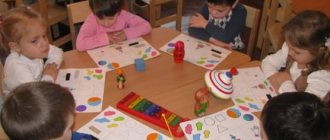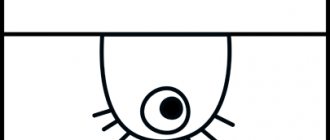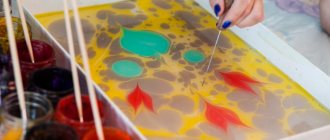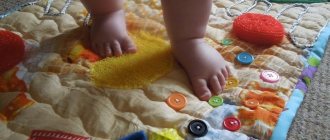I.A. Galkina (Ph.D.)
Drawing is one of the most interesting types of creative activity for preschool children. “The origins of children’s abilities and talents are at their fingertips. From the fingers, figuratively speaking, come the finest threads - streams that feed the source of creative thought. In other words, the more skill in a child’s hand, the smarter the child,” writes V. A. Sukhomlinsky. By drawing, a child develops himself both physically and mentally, since the functioning of fine motor skills directly affects the functioning of the brain. Children who draw well reason more logically, notice more, and listen more attentively. Fine arts classes train the child’s hand and fingers, which creates favorable conditions for the development of writing skills. The creation of images and fantasies contributes to the development of logical and spatial thinking, the development of associative thinking, which is necessary when mastering mathematics. The famous teacher I. Disterweg believed: “The one who draws gets more in one hour than the one who just watches for nine hours.” According to scientists, children's drawing is involved in the development and coordination of interhemispheric relationships, since the process of drawing involves both concrete figurative thinking, associated mainly with the work of the right hemisphere of the brain, and abstract logical thinking, for which the left hemisphere is responsible.
Being associated with the most important mental functions - vision, motor coordination, speech and thinking, drawing not only contributes to the development of each of these functions, but also connects them with each other.
While drawing, the child develops fine motor skills, trains memory and attention, learns to think and analyze, fantasize, measure and compare. Children develop coherent speech through drawing activities. Drawing is involved in the construction of visual images, helps to master forms, and develops sensory-motor coordination. Children comprehend the properties of materials, learn the movements necessary to create certain shapes and lines. All this leads to a gradual understanding of the environment, the child’s aesthetic feelings and abilities develop.
For the mental development of children, the gradual expansion of the stock of knowledge based on ideas about the variety of forms of spatial arrangement of objects in the surrounding world, various sizes, and a variety of shades of colors is of great importance. The formation of ideas about objects requires the acquisition of knowledge about their properties and qualities, shape, color, size, position in space. Children define and name these properties, compare objects, find similarities and differences, that is, perform mental actions. Thus, visual activity promotes sensory education and the development of visual and figurative thinking.
The assimilation and naming of shapes, colors and their shades, spatial designations contributes to the enrichment of the vocabulary; statements in the process of observing objects, when examining objects, buildings, as well as when examining illustrations and reproductions of artists’ paintings have a positive effect on the expansion of vocabulary and the formation of coherent speech.
In the process of drawing, preschoolers master many practical skills that will later be needed to perform a wide variety of jobs and acquire manual skill, which allows them to feel more independent. If a child regularly draws, then he develops such traits as perseverance, attentiveness, patience, accuracy, and the ability to plan the work process, which are very important when starting school.
The importance of visual activity also lies in the fact that it is a means of aesthetic education. The direct aesthetic feeling that arises when perceiving a beautiful object includes various constituent elements: a sense of color, a sense of proportion, a sense of form, a sense of rhythm. For the aesthetic education of children and for the development of their visual abilities, familiarity with works of fine art is of great importance. Gradually, children develop artistic taste.
Drawing also gives you the opportunity to freely express your emotions, thoughts and sensations. By drawing, the child receives joy and pleasure, as well as satisfaction from his work and from life itself, so drawing is useful for children to relieve stress and reduce emotional and psychological stress.
Advice for parents on organizing children's visual arts activities
- To introduce a child to the world of artistic creativity, it is recommended to use pencils and paints. It is worth paying attention to the choice of pencils for children. They should be soft enough to leave marks even with little force. It is advisable to purchase paints in bright shades, and be sure to have brushes of different sizes. Since a child cannot control the pressure when drawing with felt-tip pens, it is therefore not recommended to use them. Here, the important role of the adult is to trace the process of children’s assimilation of various methods of working with brushes and paints: on a dry background, on a wet background, and by washing. Children are taught to mix paints with white (in gouache) and dilute with water (in watercolor) to obtain different shades of colors; use different methods of drawing and obtaining shades of color, use different techniques when creating an image (simple pencil and paints - gouache, watercolor: colored wax crayons and gouache or watercolor, etc.).
- For a 4-5 year old child, you don’t have to buy a sketchbook, but simply buy cheap printer paper. At this age, children draw a lot and quickly, and this option will be convenient for both them and their parents. For preschoolers who will be going to school next year, on the other hand, it is best to buy a real sketchbook. Let your child learn to draw on paper of this format, so he will feel more confident in drawing lessons at school.
- A lot depends on the initial lessons in drawing and coloring. If you do not pay attention to how a child holds a writing object, this may further affect their preparation for school. First of all, take a closer look at whether the child is holding the pencil (brush) correctly. His arm should not be too tense, and his hand should not be rigidly fixed. When drawing, it is important to be able to move freely and uninhibitedly. This will make the strokes lighter and smoother. Pay attention to the child's posture. It is necessary to sit upright, coloring with one hand, and holding a sheet of paper or notebook with a drawing with the other. The adult’s task is to teach the child to hold a brush and pencil with three fingers (between the thumb and middle finger, holding it on top with the index finger), while the hand lies on the table up to the elbow or can be raised, leaning on a drawing pencil (or brush, chalk, etc. .). You need to draw with a pencil with different pressure (lightly touching the paper to get light shades and thin, light lines and pressing harder to get bright color and strong energetic lines). This will allow you to achieve expressiveness of lines and images, since the line is one of the main components of the drawing. When painting with a brush, children learn to draw lines with the entire bristle and the end of it to obtain wide and thin lines.
- Show your child that you can color pictures using strokes of different lengths. Let there be very short strokes at the very edge, and long strokes closer to the center. You need to paint in one direction, without gaps, pressing evenly on the pencil. When drawing, pay attention to the appropriate use of color. You can use the following exercises: “Color it too”, “What is this color”.
- Make “albums” where you will place your child’s drawings. Hang one or two of your child's best works on the door or refrigerator and let him tell your guests about his drawings.
- For the comprehensive development of drawing skills in children, conduct various types of classes: subject drawing (doing work from life), drawing by choice, drawing by idea, plot drawing, decorative drawing.
- The most common drawings are drawings from life. Ask your child to draw himself, looking in the mirror, his favorite toy, mom, dad. You can use photographs. Before you start drawing, discuss with your child the features of the object being depicted. If unusual details appear in the drawing, be sure to ask where they came from. To develop children's creativity while drawing, you should not insist on the authenticity of the image.
- The child has his own vision, his own attitude towards what he draws.
- At the initial stage of teaching children to draw, it is advisable to include a large number of playful moments in classes and play with objects. Basic techniques of the preparatory period: demonstration, hand-in-hand technique. In the future, the following techniques are more often used: partial display, explanation. Use non-standard drawing methods, it is very exciting, interesting and useful (for example, finger drawing, palm painting, etc.).
Of course, parents can teach their children how to draw on their own, using their own experience and special teaching aids. But drawing classes for children, taught by a professional artist, an artist-teacher who knows all the intricacies of the process of learning to draw, are very useful. In our developmental classes in fine arts (FINE and ARTWORK) are taught by experienced and highly professional artists with special pedagogical training. On our website and in the building you can see wonderful drawings by our children.
Unconventional drawing techniques. Finger painting. Journey to the Land of Imagination.
Finger painting
Hand drawing is one of the most ancient painting techniques! It develops creativity at any age.
Finger painting helps to release pent-up creative energy and express your “I.”
A lot of good research has now been written about the benefits of such activities and their impact on the development of a child’s personality. The emotional and bodily (physical) development of children is accelerated, the consequences of birth stress and illness are eliminated, fine motor skills of both hands develop perfectly, speech development accelerates and becomes more complex, work and volitional qualities are cultivated, a sense of beauty and self-esteem is cultivated, ways of conveying the beauty of the surrounding world are learned and much more. Psychologists all over the world recognize the calming effect of hand drawing.
“Finger painting” is “a way of conveying emotions, feelings and states that come from the depths of a person’s heart through direct contact of the fingertips with paints and paper.” And what is most valuable is that spontaneous painting does not require the ability to draw; there is only a non-judgmental perception of what is drawn (“the heart is at the tips of the fingers”).
The classes are so exciting that children and adults themselves do not notice how they are involved in the therapy process. There is a process of transformation of negative thoughts and emotions into creative feelings. These feelings are reflected in the painting. The therapeutic effect is observed not only at the moment of creating the picture, but also subsequently, being a powerful positive dominant.
The tasks of such visual activities
- instill in children an interest in unconventional drawing techniques - finger painting;
- develop children's creative imagination and fantasy;
- cultivate accuracy in work, teach how to finish a job;
- cultivate attention, observation and an aesthetic attitude to reality;
- learn to sit at the table correctly, hold your body and arms correctly:
- teach drawing by blotting with fingertips, phalanges, fist, palm, finishing the image by drawing details;
- learn to draw straight lines from top to bottom, from left to right, intersect them, draw curved lines, connect straight and curved lines, and also close them; teach children to depict objects of round, rectangular and triangular shapes; combine depicted objects into a composition;
— learn how to independently embody your own ideas in a drawing;
— teach children to distinguish, name and use colors in their work /red, blue, green, yellow, brown, black, white/, to know their shades /pink, blue, gray/.





